 Chinchilla genetics is a complex subject and below are some terms you should first become familiar with. In this section we shall be looking at the genetics for colour mutation.
Chinchilla genetics is a complex subject and below are some terms you should first become familiar with. In this section we shall be looking at the genetics for colour mutation.
Heterozygous - Is a term when a chinchilla has has two genes different to one another (i.e. Aa – a dominant gene (A) and a recessive gene (a)). Only one of the genes - the dominant one, is fully expressed, although the recessive gene is capable of being passed-on to future offspring.
Homozygous - Is a term when a chinchilla has either two 'dominant genes' (AA) or two 'recessive' genes (aa). A Standard Grey chinchilla has two recessive (aa) Grey genes and a Homozygous Beige has two dominant (AA) Beige genes. WARNING - White and any TOV cannot exist in the 'homozygous' state, the reasons are discussed further on.
Dominant Gene - Is normally indicated with a capital letter (for example – A). The dominant gene colours in chinchillas are: White, Beige and Standard TOV (Black Velvet).
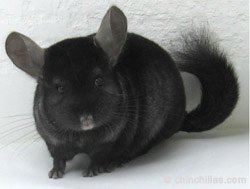 Weakly Dominant Gene - Ebony is a weakly dominant gene, which accumulates its colour strength depending on how many generations the gene has been bred through. The Ebony gene is not theoretically one colour gene but a combination of several colours that do not work in the normal recessive manner. Ebony is similar to the TOV gene where its influence is more for color DEPTH rather than actual color - as it darkens and solidifies any color that it is combined with. The Ebony gene creates a 'Wrap' effect where the colour extends beneath the underbelly where the fur will not be White as it usually is.
Weakly Dominant Gene - Ebony is a weakly dominant gene, which accumulates its colour strength depending on how many generations the gene has been bred through. The Ebony gene is not theoretically one colour gene but a combination of several colours that do not work in the normal recessive manner. Ebony is similar to the TOV gene where its influence is more for color DEPTH rather than actual color - as it darkens and solidifies any color that it is combined with. The Ebony gene creates a 'Wrap' effect where the colour extends beneath the underbelly where the fur will not be White as it usually is.
A Standard Grey chinchilla is 'Recessive' to White, Beige and Standard TOV.
A dominant gene will be passed on to any offspring and will mask (hide) the effect of any recessive genes or incomplete dominant genes.
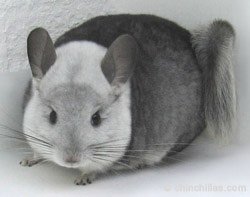 Incomplete dominant gene - The genes involved for creating a White chinchilla are not completely dominant, which means some of the standard fur can also be shown producing a variety of different patterns of White and Grey fur. There are many different names for these individual patterns - Silver, Mosaic, Reverse Mosaic.
Incomplete dominant gene - The genes involved for creating a White chinchilla are not completely dominant, which means some of the standard fur can also be shown producing a variety of different patterns of White and Grey fur. There are many different names for these individual patterns - Silver, Mosaic, Reverse Mosaic.
The extreme difference between the patterning occurs because White genes behave as a 'pigment inhibitor', which means the colour White itself does not show itself within the fur but instead stops another colour mutation from expressing itself within the parts of fur effected by the White gene.
This gene actually stops the 'coloured' pigment from absorbing into the hairs at all. This effect is then either expressed all over the chinchillas fur, within patches or evenly blended with another colour such 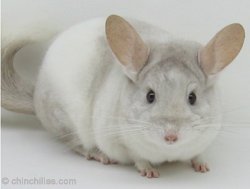 as the Silver colour mutation.
as the Silver colour mutation.
There is a lethal gene connect to the White gene the same as any TOV (Touch of Velvet), where these genes cannot exist in the homozygous state.
As the White gene can express itself to such varying degrees within the fur and is sometimes hard to extinguish the best diagnosis is whether there is any White expressing itself within the tail. All chinchillas that carry the White gene will show some portion of white within the tail, either from the whole tail to just a small amount on the tip.
Recessive Gene - Is normally indicated with a non-capital letter (for example – a). The recessive 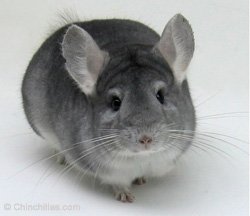 gene colours are: Recessive Beige, Violet, Sapphire and Charcoal.
gene colours are: Recessive Beige, Violet, Sapphire and Charcoal.
The Standard Grey chinchilla has two recessive genes (aa) which are 'grey' influenced but is classed as 'dominant' to the above recessive colour mutations.
A recessive gene will not show its colour trait in the Heterozygous (aa) state but only be expressed in the Homozygous (AA) state. This means, if you wanted to produce Sapphire (for example) 'in the first generation', you would have to breed 'homozygous (AA) sapphires' together (which would produce 100% sapphire offspring). However, recessive genes in the heterozygous state (Aa) can be 'Carriers' of the recessive gene.
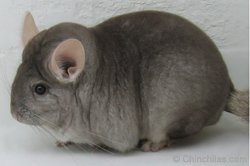 Carriers - There are also recessive colour mutations known as 'Carriers', which generally look like another colour mutation but have a 'hidden' gene that will produce offspring of whatever colour is being carried when bred to another chinchilla or 'carrier' of the same hidden colour mutation.
Carriers - There are also recessive colour mutations known as 'Carriers', which generally look like another colour mutation but have a 'hidden' gene that will produce offspring of whatever colour is being carried when bred to another chinchilla or 'carrier' of the same hidden colour mutation.
For example a Beige / Ebony carrier has a gene structure of dominant Beige + recessive Ebony. The Ebony wont be exposed in the fur but the chinchilla will be a Ebony carrier, which may expose itself in offspring when bred with another Ebony carrier.
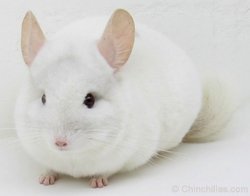 Co-Dominant Genes - are two or more dominant genes existing together. For example: White + Beige = Pink White (Beige Mosaic/Golden Mosaic).
Co-Dominant Genes - are two or more dominant genes existing together. For example: White + Beige = Pink White (Beige Mosaic/Golden Mosaic).
Co-Recessive Genes - are two or more recessive genes existing together. For example: Standard Grey + Sapphire = Standard Grey (Sapphire Carrier). As the Standard Grey is more 'dominant' over the recessive colour mutations, it is always this colour you will see with hidden genes of the mutations bred together. For example, Violet + Sapphire = Standard Grey (Violet-Sapphire Carrier).
TOV Gene - A gene for color PATTERN rather than color. The term TOV is generally used on any colour mutation that expresses the 'veiling gene' to produce a darker shade across the face - running down the spine and tail of a chinchilla. A good specimen will also express the veiling down the sides.
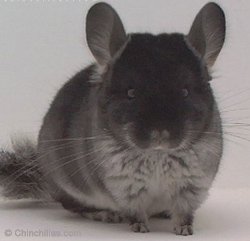 The 'veiling' gene can take up to 1 year to fully express itself and provide full coverage from the tip of the nose to the base of the tail with no break within the veiling strip.
The 'veiling' gene can take up to 1 year to fully express itself and provide full coverage from the tip of the nose to the base of the tail with no break within the veiling strip.
There is also a noticeable stripe on the front paws of a TOV chinchilla as the colouration extends down the leg as dark lines known as a Paw Spat
The TOV Gene is produced by breeding a Black Velvet chinchilla with another colour mutation. This combination will produce many different colour mutation varieties such as
- Standard TOV (known as the Black Velvet) - TOV Beige (known as Brown Velvet) and TOV White (also known as White/Black Cross or Black/White Cross) - TOV Violet - TOV Sapphire.
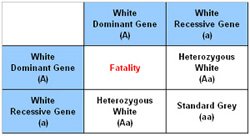
Lethal Gene - This applies solely to White and any TOV colour mutation. It is not possible for these two colour mutations to exist in their homozygous forms.
For example - you cannot produce a Homozygous White chinchilla as the foetus will never fully develop in the womb. If a foetus has formed by two white or TOV genes fusing together, then it will be reabsorbed or be of severely poor quality.
You can still breed a TOV - TOV and a White - White but it is not advised due to possibilities of future infertility in the chin-mum and 25% less off-spring being produced (see diagram above).
So how is it all put together ?
Read on ...

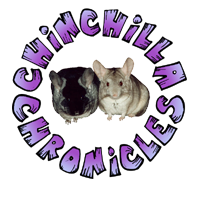



 as the Silver colour mutation.
as the Silver colour mutation. gene colours are: Recessive Beige, Violet, Sapphire and Charcoal.
gene colours are: Recessive Beige, Violet, Sapphire and Charcoal. Carriers - There are also recessive colour mutations known as 'Carriers', which generally look like another colour mutation but have a 'hidden' gene that will produce offspring of whatever colour is being carried when bred to another chinchilla or 'carrier' of the same hidden colour mutation.
Carriers - There are also recessive colour mutations known as 'Carriers', which generally look like another colour mutation but have a 'hidden' gene that will produce offspring of whatever colour is being carried when bred to another chinchilla or 'carrier' of the same hidden colour mutation. Co-Dominant Genes - are two or more dominant genes existing together. For example: White + Beige = Pink White (Beige Mosaic/Golden Mosaic).
Co-Dominant Genes - are two or more dominant genes existing together. For example: White + Beige = Pink White (Beige Mosaic/Golden Mosaic). The 'veiling' gene can take up to 1 year to fully express itself and provide full coverage from the tip of the nose to the base of the tail with no break within the veiling strip.
The 'veiling' gene can take up to 1 year to fully express itself and provide full coverage from the tip of the nose to the base of the tail with no break within the veiling strip.